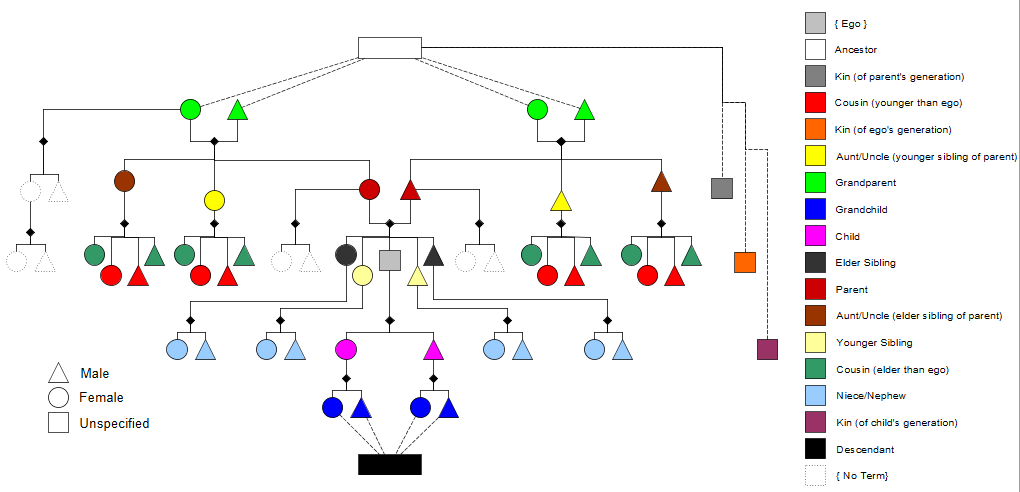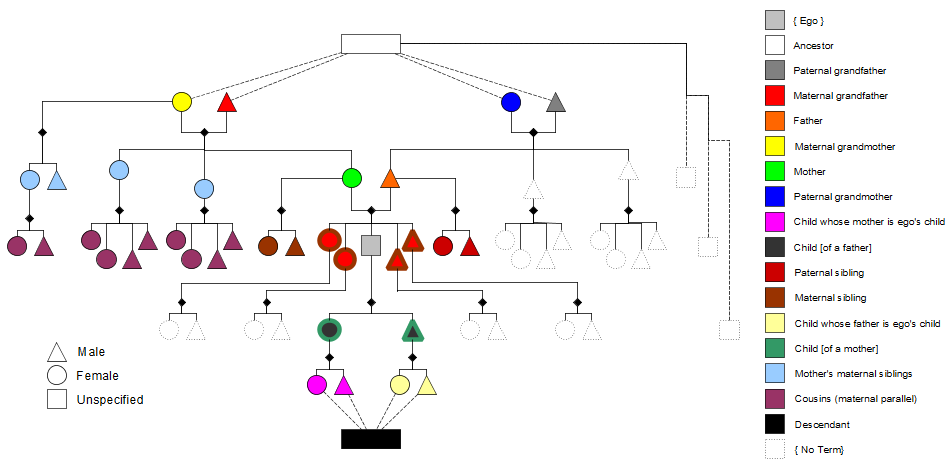Anthologica Universe Atlas / Forums / Department of Creativity / Kinship Systems and Terminology in your Con-stuff / Kinship Systems and Terminology in your Con-stuff
Wherein I ramble about the kinship terms I've been working and ask for feedback, and you can do the same!
Please to be telling me what you think of the following. I have not really handled kinship much before and I don't know WTF I am doing.
The Second Language (2L) has two separate kinship systems running in parallel. The first system is "official" kinship (hv̄k /huk/), that is, formal and legally recognized by the celestial court. The second, considered inferior, is blood kinship (grŕk /↑ŋɹak/). As usual 2L works on a sixteen-words-under-a-hyponym system - so there are sixteen root1 kinship terms for each system. For anyone who's been following how 2L vocabulary works and its connection to the gods, official kinship is the Anthesis/Anthesis section and blood kinship Anthesis/Ascesis.
Charts! (With apologies to the colourblind )
)
Official Kinship

Blood Kinship

Maternal uncles and paternal aunts have been left off the charts due to space and idiocy. Nothing much interesting is happening there, but for clarity:
Official Kinship: Maternal uncles and paternal aunts are elder/younger aunts/uncles. Their children are elder/younger cousins.
Blood Kinship: maternal uncles are "mother's maternal siblings", there is no term for their children. There are no terms for paternal aunts or their children.
The chart form was designed to compare the two systems, but be aware that for a single target individual the two charts might not refer to the same people. For example if you are adopted you have official parents different to your blood ones. If you are illegitimate you might have no official parents at all. Lists of officially recognised children versus actual offspring can be very different, and so on.
Official Kinship: Elder and Younger
"Elder" and "younger" terms are strongly influenced by relative social status. A sibling or cousin of a higher social status is referred to as "elder" regardless of relative age, and similarly lower status relatives are "younger". Only where social status is roughly equal to the terms correspond to relative age.
[I can't decide if the elder/younger status of aunts/uncles should be judged relative to ego, or to ego's related parent. Thoughts?]
Blood Kinship: Sex
The blood kinship system is remarkable in the context of 2L for recognising biological sex in some sense (as opposed to Vanan four-category gender). Strictly what it recognises the concept of "mother" (the one who bore a child) versus "father" (other genetic contributor[s]).
Blood Kinship: Children
Blood kinship has two terms for "child/offspring", specifying whether they are being considered as a child of the mother or a child of the father. Mothers will use the first term for their children, fathers the latter.
Blood Kinship: Full Siblings
Full siblings can be referred to as either maternal or paternal siblings. There is no specific term for full siblinghood in the blood kinship system.
Please to be telling me what you think of the following. I have not really handled kinship much before and I don't know WTF I am doing.
The Second Language (2L) has two separate kinship systems running in parallel. The first system is "official" kinship (hv̄k /huk/), that is, formal and legally recognized by the celestial court. The second, considered inferior, is blood kinship (grŕk /↑ŋɹak/). As usual 2L works on a sixteen-words-under-a-hyponym system - so there are sixteen root1 kinship terms for each system. For anyone who's been following how 2L vocabulary works and its connection to the gods, official kinship is the Anthesis/Anthesis section and blood kinship Anthesis/Ascesis.
Charts! (With apologies to the colourblind
Official Kinship

Blood Kinship

Maternal uncles and paternal aunts have been left off the charts due to space and idiocy. Nothing much interesting is happening there, but for clarity:
Official Kinship: Maternal uncles and paternal aunts are elder/younger aunts/uncles. Their children are elder/younger cousins.
Blood Kinship: maternal uncles are "mother's maternal siblings", there is no term for their children. There are no terms for paternal aunts or their children.
The chart form was designed to compare the two systems, but be aware that for a single target individual the two charts might not refer to the same people. For example if you are adopted you have official parents different to your blood ones. If you are illegitimate you might have no official parents at all. Lists of officially recognised children versus actual offspring can be very different, and so on.
Official Kinship: Elder and Younger
"Elder" and "younger" terms are strongly influenced by relative social status. A sibling or cousin of a higher social status is referred to as "elder" regardless of relative age, and similarly lower status relatives are "younger". Only where social status is roughly equal to the terms correspond to relative age.
[I can't decide if the elder/younger status of aunts/uncles should be judged relative to ego, or to ego's related parent. Thoughts?]
Blood Kinship: Sex
The blood kinship system is remarkable in the context of 2L for recognising biological sex in some sense (as opposed to Vanan four-category gender). Strictly what it recognises the concept of "mother" (the one who bore a child) versus "father" (other genetic contributor[s]).
Blood Kinship: Children
Blood kinship has two terms for "child/offspring", specifying whether they are being considered as a child of the mother or a child of the father. Mothers will use the first term for their children, fathers the latter.
Blood Kinship: Full Siblings
Full siblings can be referred to as either maternal or paternal siblings. There is no specific term for full siblinghood in the blood kinship system.
_________________________
1. 2L is built on a rather large list of single-syllable root words. The vocabulary, including kinship vocabulary, is extended with compounds, but these are not part of the precisely ordered root system.
1. 2L is built on a rather large list of single-syllable root words. The vocabulary, including kinship vocabulary, is extended with compounds, but these are not part of the precisely ordered root system.
